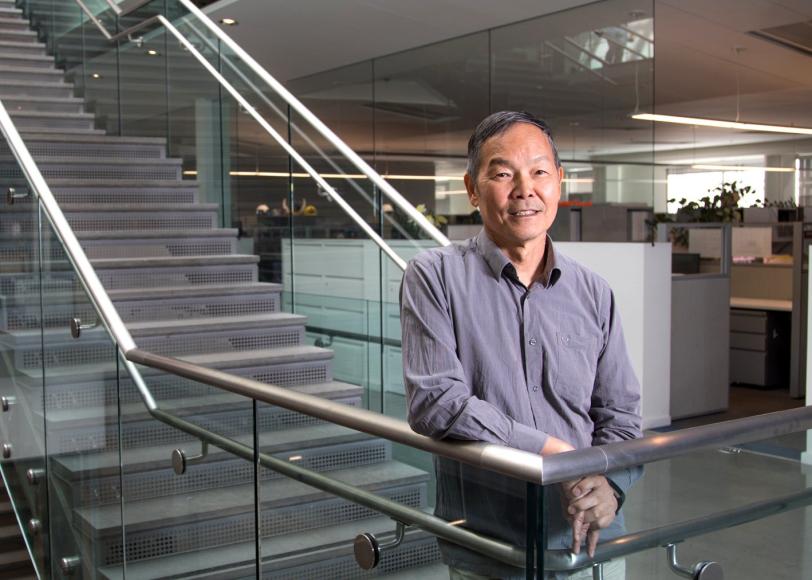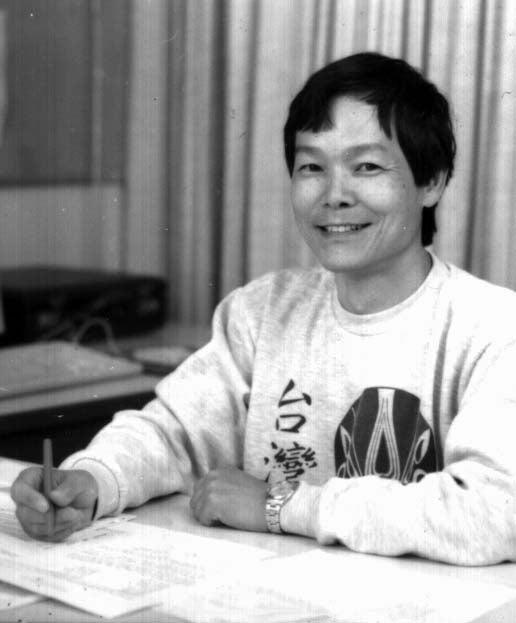SLAC Accelerator Physicist Alexander Chao Wins American Physical Society’s Wilson Prize
He is recognized for his numerous contributions to the advancement of accelerator physics, community service and education.
By Manuel Gnida
Alexander Chao, a professor emeritus of particle physics and astrophysics at Stanford University and the Department of Energy’s SLAC National Accelerator Laboratory, has been recognized with the 2018 Robert R. Wilson Prize for Achievement in the Physics of Particle Accelerators. Awarded by the American Physical Society (APS), the prize honors Chao’s contributions to our understanding of how to build, operate and improve complex, accelerator-based discovery devices; his service to the research community; and his engagement in the education of engineers and scientists in the field.
Over the years, Chao’s work has touched many aspects of accelerator science, often addressing the challenges of creating and maintaining stable particle beams that probe the fundamental components of matter or generate ultrabright X-rays for unprecedented atomic-level studies in chemistry, biology and materials science. Particle accelerators are also widely used in medicine, industrial manufacturing, national security and other areas.
“Alex’s numerous seminal contributions to accelerator physics have played crucial roles in the design and performance of many accelerators around the world,” says Lia Merminga, director of SLAC’s Accelerator Directorate. “He has set an extraordinary example for others and has shaped the scientific direction and development of many fledgling physicists, including me, through insightful teaching, mentorship, understanding and support.”
Chao says, “The Wilson Prize is a double honor. The award itself is very prestigious, but I also feel extremely honored on a personal level because the prize reflects the immense support from my friends, colleagues and supervisors.”

Career Beginnings at SLAC
Chao’s career started in 1974, when he came to SLAC after obtaining a PhD in physics from Stony Brook University, New York.
“My thesis was in high-energy physics, but during my last year, I already spent half of my time studying accelerator physics,” he says. “That’s when I decided and paved my path to come to SLAC and become an accelerator physicist.”
Quickly advancing from postdoctoral researcher to staff scientist, Chao spent the next 10 years at the lab studying fundamental problems relevant to SLAC’s accelerator-driven research program. That was a fun time, he says, with a lot of freedom to work on a wide range of important topics, such as understanding the complicated mechanisms of polarization and depolarization in beams of charge particles. “I invented a way of calculating these effects,” he said. “I believe that was my first significant scientific work in the field.”
Chao also studied other phenomena affecting the stability of particle beams, including the charge interaction of colliding beams and the beams’ interaction with the beam pipe through which they fly, which are key to accurately predicting and controlling beam behavior in particle accelerators.
Super Collider and Return to SLAC
In 1984, Chao left SLAC to join the Superconducting Super Collider (SSC) project, which planned and began construction of a gigantic proton-proton collider in Texas that would have been 54 miles in circumference – about three times larger than today’s Large Hadron Collider (LHC) at CERN, the European particle physics laboratory.
In the SSC, about 8,000 superconducting magnets would have kept the proton beams on their circular path. In his role as the head of SSC’s accelerator physics design team, one of Chao’s critical tasks was to understand and calculate deformations in the magnetic fields and to determine the optimal magnet size – one of the project’s prime cost-determining parameters.
After the SSC project was cancelled in 1993, Chao returned to join the SLAC and Stanford faculty, where he lent his accelerator expertise to a broad range of projects. He also participated in activities related to the Linac Coherent Light Source (LCLS), a DOE Office of Science User Facility that generates X-rays a billion times brighter than those available before, and to plasma accelerator techniques that could drastically shrink the size of future accelerators and reduce their cost.

Serving and Educating the Community
In addition to his scientific accomplishments, the Wilson Prize recognizes Chao’s tireless community leadership, in roles such as a co-editor of the “Handbook of Accelerator Physics and Engineering,” which is widely used by accelerator practitioners, and as an editor of the scientific journal “Reviews of Accelerator Science and Technology.”
“Community service may not give you immediate recognition, but it’s such an integral part of a striving community,” Chao says. “It should definitely be more emphasized, and we should all do a little to support our scientific community and make it better.”
Another matter close to Chao’s heart is the education of next-generation accelerator physicists, exemplified by his participation as a teacher at the U.S. Particle Accelerator School (USPAS), a national graduate program in the science of particle beams and associated accelerator technologies, for almost 30 years. In 2016, USPAS presented him with an “Iron Man” service award in recognition and appreciation of exceptional contributions in teaching at the school’s sessions. In January 2017, Chao received the USPAS Prize for Achievement in Accelerator Physics and Technology.
Next in the Plan
Chao retired in July of this year, but he will remain an active member of SLAC and the accelerator community at large. He is now devoting a significant amount of his time to developing a new method, called steady state microbunching (SSMB), to generate highly intense light from small circular electron storage rings. In the technique, which Chao co-invented with SLAC colleague Daniel Ratner a few years ago, the electrons interact with a laser inside a magnetic structure, resulting in an intensity boost for the light produced by the electrons in the ring.
If successful, the development could pave the way for novel sources of high-power extreme ultraviolet (EUV) light – radiation that the semiconductor industry uses for the fabrication of integrated circuits. “Right now, industry uses expensive plasma devices to produce EUV radiation with limited power,” Chao says. “If SSMB works, a small storage ring could deliver the needed power at a fraction of the cost.”
The Wilson Prize consists of a $7,500 cash reward, an allowance for travel to the meeting at which the prize is awarded, and a certificate citing the contributions made by the recipient. Chao is the fourth SLAC researcher to receive the prize, joining past honorees James Bjorken (2017), John Galayda (2013) and John Seeman (2004).
Contact
For questions or comments, contact the SLAC Office of Communications at communications@slac.stanford.edu.
SLAC is a multi-program laboratory exploring frontier questions in photon science, astrophysics, particle physics and accelerator research. Located in Menlo Park, Calif., SLAC is operated by Stanford University for the U.S. Department of Energy's Office of Science.
SLAC National Accelerator Laboratory is supported by the Office of Science of the U.S. Department of Energy. The Office of Science is the single largest supporter of basic research in the physical sciences in the United States, and is working to address some of the most pressing challenges of our time. For more information, please visit science.energy.gov.





